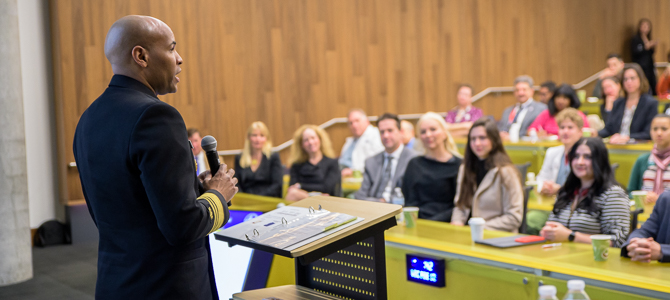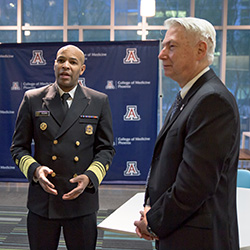
U.S. Surgeon General Visits College, Addresses Country’s Most Pressing Health Issues

The United States Surgeon General Vice Admiral Jerome M. Adams, MD, MPH, visited the University of Arizona College of Medicine – Phoenix Feb. 13 to deliver a message about the priorities of his office and the state of the nation’s health. The Surgeon General participated in Grand Rounds hosted by the Arizona Department of Health Services and the college.
In a wide-ranging call to action, Dr. Adams encouraged physicians to use their voices to help businesses, politicians and voters understand that investing in health is essential to the economic health of their community.
He also prompted them to address physician burnout, become certified to carry the overdose-reversing drug naloxone and work to dispel stigmas associated with mental health, addiction and access to care.
As the “nation’s doctor,” Dr. Adams said he sees his role as using evidence-based science to promote health and prevent disease.
“I’m known as the nation’s doctor, but my most important role is representing the nation’s patients,” said Dr. Adams, an anesthesiologist. As Surgeon General, he holds the rank of Vice Admiral in the U.S. Public Health Service Commissioned Corps. He oversees operations of 6,500 uniformed health officers, who serve in 800 locations around the world to promote, protect and advance the health and safety of the U.S.
Dr. Adams shared his personal experience of his family’s health issues: one grandfather, a smoker, died of lung cancer; another grandfather had a stroke from hypertension; his wife is being treated for metastatic melanoma; and several relatives suffer from substance use disorders, including his younger brother who is serving a 10-year prison sentence for crimes to support an opioid addiction.
“I share those stories because a lot of us hide those stories,” he said. “As Surgeon General, I’m always asked about the biggest problems: diabetes, cancer, opioid addition, e-cigarettes. Across the board, the biggest problem is stigma. Stigma prevents people from coming forward to confront their issues, from seeking help.
“I represent people across the country suffering not only from disease, but from lack of access, from barriers that lead to these diseases in the first place.”
He told the group about treating a young man who had been shot. The first time he saved his life, Dr. Adams said, he felt invigorated. Within the next 10 years, the man returned to the hospital two more times: once he had been stabbed, and the last time he had been shot again.
“The third time I saw that young man, I was thinking, ‘Is this really a good use of my time? Who else could I be helping and changing their life relative to seeing this young man over and over?’ That to me is physician burnout. We need to change the narrative, so that physicians and health care providers can really feel like they are making a difference.”
Regarding the rapid rise in opioid-related deaths, he said physicians have done a great job decreasing opioid prescriptions by 22 percent nationwide over five years. Even though there have been great strides, he said, there has been a dramatic spike in overdose rates due to illicitly manufactured fentanyl and users using heroin.

Dr. Adams shared additional shocking statistics:
- In America, 2.1 million people are struggling with opioid use disorder, and in 2017, 70,000 people died from an opioid overdose, a record. A person dies of an opioid overdose every 11 minutes, and more than half of those die at home.
“We need everyone to become a first responder. My office is working to put naloxone not just in the hands of first responders, but community members. Please read my naloxone advisory. I ask all of you to be willing to carry naloxone, so we can turn around the opioid epidemic.”
- One in 20 middle school students and one in five high schoolers used e-cigarettes in 2017, a 78 percent increase from the previous year. It was the largest increase in youth use of any substance in the 40 years the Surgeon General’s office has surveyed youth drug use.
“We have seen a decline in tobacco use for the last 20 years,” he said. “We’re losing the gains we’ve made, and it’s all because of e-cigarettes. I don’t want us to see a new generation addicted to nicotine. A JUUL (e-cigarette) pod contains as much nicotine as an entire pack of cigarettes. Nicotine has a unique effect on learning and attention in young people, which we know can prime a young brain for addiction.”
- Seven out of 10 18-25 year olds are ineligible for military service in the U.S. because they can’t meet the education requirements, can’t pass the physical requirements or have a criminal background.
“All three of those are affected by our nation’s poor health,” he said. “You can’t educate a child if a child isn’t healthy. People can’t pass the physical because our kids are in front of screens and we’re force-feeding them processed food. Our national security is less than what it should be because our nation’s health is less than what it should be.”
- Today’s marijuana extracts contain more than 50 percent THC, the chemical compound in cannabis responsible for a euphoric high. In the 1980s and 1990s, marijuana contained less than 5 percent THC.
“It’s important for you as physicians to help your patients understand that this is not your parents’ marijuana,” Dr. Adams said. “Medical marijuana is complicated, and we need a more nuanced discussion than tweets and sound bites.”
To the medical students in the audience, Dr. Adams asked them to consider serving in uniform. “There are many ways you can serve with your health degree,” he said. “It’s a tremendous honor, and we are doing great things to protect the country.”
He urged them to be “game changers and disruptors” in the medical community, adding that he is looking forward to the impact they will make on the future of medicine.
Photos, Video and Presentation
Topics
About the College
Founded in 2007, the University of Arizona College of Medicine – Phoenix inspires and trains exemplary physicians, scientists and leaders to advance its core missions in education, research, clinical care and service to communities across Arizona. The college’s strength lies in our collaborations and partnerships with clinical affiliates, community organizations and industry sponsors. With our primary affiliate, Banner Health, we are recognized as the premier academic medical center in Phoenix. As an anchor institution of the Phoenix Bioscience Core, the college is home to signature research programs in neurosciences, cardiopulmonary diseases, immunology, informatics and metabolism. These focus areas uniquely position us to drive biomedical research and bolster economic development in the region.
As an urban institution with strong roots in rural and tribal health, the college has graduated more than 1,000 physicians and matriculates 130 students each year. Greater than 60% of matriculating students are from Arizona and many continue training at our GME sponsored residency programs, ultimately pursuing local academic and community-based opportunities. While our traditional four-year program continues to thrive, we will launch our recently approved accelerated three-year medical student curriculum with exclusive focus on primary care. This program is designed to further enhance workforce retention needs across Arizona.
The college has embarked on our strategic plan for 2025 to 2030. Learn more.